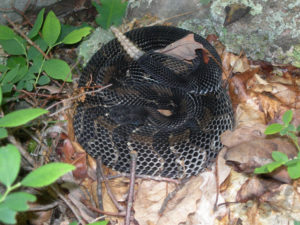Education key to understanding, protecting snakes
Within minutes of meeting William Fox Munroe, of rural Millville, it is apparent that he is a natural-born educator.
Although his teaching subject may be little more slithery than many would want.
Munroe is a herpetological biologist who was entrusted with helping lessen the ecological effects of the natural gas pipeline project in the Northern Tier counties on hundreds of timber rattlesnakes and various other reptiles and amphibians.
His ultimate goal is to educate the public and help protect our natural resources. His biggest enemy is common misconception and misplaced fears.
“Some kid puts a frog down the shirt of a girl in school, and she develops a life-long fear of frogs,” he explained. “Education is huge. People fear things they don’t understand. And what right do any of us have walking around in the woods if we don’t understand and respect the wildlife that calls those woods home?”
When it comes to snakes, approximately 2,000 Americans are bitten annually, according to Munroe. On average, just two people die each year nationally, he said.
“Compare that to 800 people who die on average each year in biking accidents, or 150 who die in lightning strikes. Over 100 people die from attacks by domestic dogs,” Munroe said. “Snakes are vulnerable creatures. They’re not aggressive — they’re defensive. Yet people seem to act as though snakes are guilty until proven innocent. Those same people have no problem killing snakes fueled mostly by ignorance and misconception.”
New opportunities
Munroe retired in 1998 from a graphic design company he created (William Fox Munroe packaging), which ultimately allowed him to work full-time with something that fascinated him his whole life.
“After 27 years, we sold the graphic design company so I could hike the Appalachian Trail. It was a goal of mine for a long time, ever since I saw the white blazes on trails while in Scouts and asking what they were,” Munroe said. “After the trail and moving to Colorado, I came back to Pennsylvania to work by invite in 2003.”
The job involved working on a special research project with Dr. Howard Reinart, who developed a way to surgically implant radio telemetry devices in reptiles.
“If you catch a tiger, you can put a tracking collar on it, but how can you do that with a snake?” Munroe said. “Dr. Reinart developed a way to insert the device protected by a combination of beeswax and parafin directly into snakes.”
The project ultimately involved researching the effects of commercial logging on snakes, and was conducted in various nearby forests, including the Tiadaghton State Forest in Lycoming County.
The study involved all aspects of logging, including pre- and post-logging practices and incorprorated items such as habitat points, vegetation, heat and temperatures, canopy densities, etc. Data was inputted into Palm Pilots by four researchers over a four-year span. The conclusive report was turned into the Department of Conservation and Natural Resources’ forestry division.
Pipeline ‘snake guy’
Making a name for himself on the project, Munroe was selected to work as a herpetological biologist on an 84-mile natural gas pipeline extension from Clinton through Huntingdon counties.
The $750 million project (approximately $9 million per mile) was unable to move forward, according to Munroe, until timber rattlesnake experts were on staff full-time since the area was considered a hot spot for the reptiles.
“We were brought in specifically to protect timber rattlesnakes, but were also in charge of protecting all reptiles and amphibians, including salamanders, fence lizards, skinks, etc.” Munroe said. “There were three of us ‘snake people,’ but only two worked at a time. We’d put in six 10-hour days a week.”
The pipeline ran parallel to another, and the wide cut through the forest provided ideal snake territory where the cold-blooded snakes could sun themselves, while also having access to man-made piles of logs and boulders left over from the first pipeline project. The habitat is perfect for snake basking, mating and denning areas. It also attracts a variety of mice and other rodents — the primary food source for timber rattlesnakes.
Munroe’s time was split between cordoning off areas of high snake activity and transplanting snakes that workers found during construction. There is a specific science to successfully moving a snake to limit unnecessary stressors, and Munroe was careful to follow the guidelines — including that timber rattlesnakes can not be moved more than 200 feet from where they are found.
More protection
He admitted that the future is brighter for timber rattlesnakes and other wildlife thanks to increased conservation guidelines for major projects. He predicts that the next wave of these projects will follow the increasing trend of windfarm construction.
“I was printing bumper stickers in 1959 that encouraged people to help preserve our timber rattlesnakes,” Munroe said. “Now here we are, 50 years later, and the state is taking steps towards better protecting them.”
Munroe’s heart and true passion remains as an educator to the public … as someone who helps people to rise above the myths surrounding snakes and to develop more respect for reptiles and amphibians in the state. He speaks at a variety of local schools and other venues.
“Thanks to the radio telemetry, we know more now than we ever did about snakes, including timber rattlers,” he said. “They are so fragile and susceptible to human interruption. Females aren’t sexually mature until they’re 6 years old, and produce live-born young only every third year. Unlike garter snakes, they only have five to 10 young at a time, and the survival rate isn’t great for them. Timber rattlesnakes are communal denners, which make them vulnerable.”


